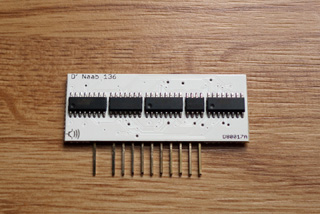Introduction
This is a perfect clone of A1QH80017A IC better known as 80017A used in the Roland JUNO-106,HS-60,GR-700,MKS-30 and MKS-7.
The previous version,
D80017, has been in production since May 2006 and is in use by people and service centers all over the world now. During it's lifespan it saw no less than 7 revisions (about a new verion every 4 months). Since the first version it sounded identically to the original chips. No one is able to hear a difference. But every time I saw something that could be improved, I changed it until it reached something close to perfection.
Due to the fact that the
PCB library I designed to cope with the problems of lead-free solder alloys is also very beneficial for lead-solder joints, I decided to also use it for this voice chip clone.
For this I had to redraw the whole thing from scratch and thus I took the time to evaluate all previous versions and their measurement data from the test procedure I did on each one. This because the type of parts used remained almost the same throughout all versions, but I did switch between manufacturers from time to time. Although all of them were within specifications, some are a lot closer on target than others. Now I order each part from the manufacturer who's test results were the most uniform for that part.
The previous version had one weak spot: The output of the VCA had no short circuit protection. This was not an issue during operation, but when doing the adjustment procedure you could destroy them by shorting 2 testpoints. And as we all know: A slip of the probe happens even to the most experienced from time to time. For this new version the output is fully protected.
Installation
Just do as is told in the ROLAND JUNO-106 SERVICE MANUAL. Nothing less, nothing more.
The JUNO-106 service manual can be downloaded here:
JUNO-106 service manual
- Although it is straightforward and perfectly described in the juno-106 service manual, this requires electronics knowledge and the proper tools: digital multimeter, oscilloscope and frequency counter (frequency adjustment can also be done with a musical instrument tuner or soundcard + frequency measurement program).
- Do not believe people who are selling originals or clones who say this is just a remove-replace-play operation. They are lying. Even if you do replace it with an original chip, this adjustment procedure is necessary. Without doing so it will sound acceptable, but not perfect.
- Tolerance of these clones is very tight. Only little adjustment should be done. All trimpots should be about center position.
Some tips for servicing can be read
here.
If you are unable to do so yourself:
- Contact a Roland service center. They will be happy to do it for you.
- CIMPLE Solutions in the UK have been repairing synths since the 80's, and know the 106's inside out and back to front! They usually stock my clones
Pictures
More pictures and extra info can be found on the page of the previous version:
D80017



